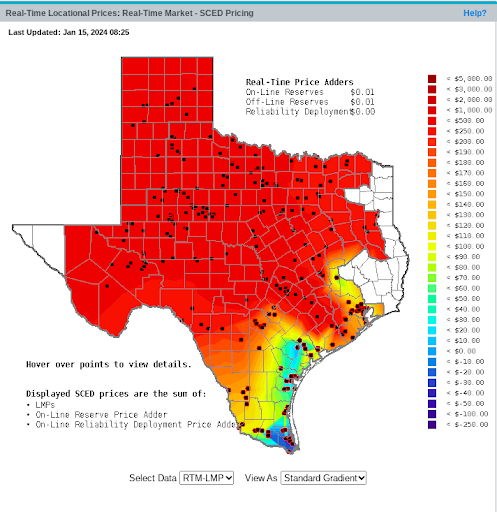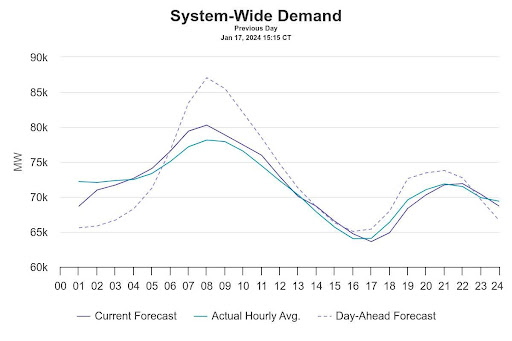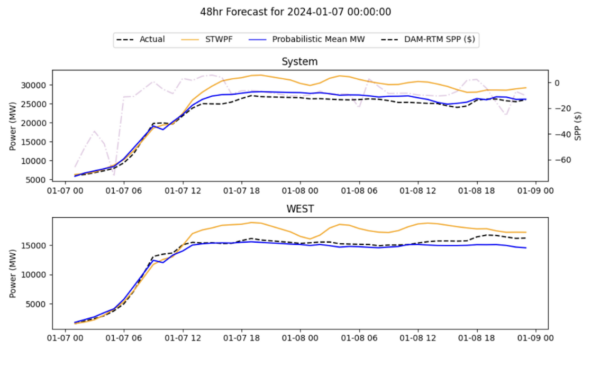The recent winter storms Finn and Heather have once again highlighted the fragility of our energy infrastructure and impact of demand and generation forecasting. These events underscore the importance of accurate forecasting for energy traders and grid operators, particularly within the Electric Reliability Council of Texas (ERCOT) market.
Impact of Storms Finn and Heather Compared to Uri (2021)
While Finn and Heather were less impactful than Uri, they severely affected market dynamics and dispatchable resources. The balance of supply and demand, already a complex interaction of atmospheric dynamics, consumer needs, and grid conditions, becomes even more precarious under such unpredictable weather events. Accurate load and variable generation predictions are thus critical for organizations looking to protect physical and financial positions in the ERCOT market.
The image below shows the real-time SCED price during the onset of Storm Heather. The transition in color from blue to red indicates the rising cost of power servicing Central, North and West Texas. Prices grew from -$250/MWh (blue) to $2000/MWh (red) as a result of renewable curtailment and severe dispatch congestion.

Source: Real-Time Locational Prices https://www.ercot.com/content/cdr/contours/rtmLmp.html
Forecasting Energy Demand: A Crucial Factor
The plummeting temperatures during these storms led to forecasted soaring residential and commercial heating demands, creating a potential gap between supply and demand. An accurate demand forecast is essential for day-ahead and real-time market dynamics. For instance, during Storm Heather, ERCOT’s forecasted system-wide demand was about 13% over the actual load at the peak demand time (9 am).
The peak demand forecast was 87,508 MW, surpassing the all-time ERCOT peak set on August 10th, 2023 of 85,508 MW. The discrepancy between predicted demand a day ahead and what’s realized in real-time can create arbitrage opportunities, price spikes or widespread outages. Utilizing highly accurate temperature and wind power forecasts is crucial for traders and generation asset owners to protect themselves or profit from highly variable market conditions caused by inaccurate forecasts and transmission congestionn.
Forecasted and Actual Demand

The Role of Improved Forecasting Tools
The Tomorrow.io forecast for surface temperatures showed a 20% reduction in mean absolute error (MAE) over the state-of-the-art Numerical Weather Prediction (NWP) High-Resolution Rapid Refresh (HRRR) model in Dallas, TX, leading up to January 15th.
This error reduction can be observed as the Tomorrow.io forecast is closer to the observed temperatures at nearly every timestep. These more accurate temperature predictions are vital in managing market volatility, as was observed during peak demand when intermittent power generation was congested in South Texas, raising costs to dispatch power to major residential and commercial hubs.

Furthermore, while concentrated in mid to northern latitudes, Winter Storm Finn sent cold temperatures and strong wind gusts up to 65 mph (8 January 2024) across Texas. These conditions are difficult to forecast wind power within due to localized wind ramp events and the impact of icing on turbine rotors.
Over the forecast window of January 7th and 8th, the Tomorrow.io wind power generation model provided an accurate forecast of wind power across the ERCOT system and across the West region.
For a consistent period of about 36-hours, the Tomorrow.io model outperformed the ERCOT Short-Term Wind Power Forecast (STWPF) at both the system and regional (i.e. West region shown below) levels. The performance improvement was significant, with the Tomorrow.io model consistently within about 1GW or less of the actual generation when at times the ERCOT model overforecast generation by about 5 GW. This had the potential to cause significant market price implications if there were transmission constraints or higher than expected load.

Conclusion: The Path Forward
The experiences from winter storms Finn, Heather, and Uri emphasize the value of accurate wind power and temperature forecasts in the energy sector. For ERCOT and its participants, the ability to predict and prepare for such events is not just about maximizing revenue and mitigating losses but also about ensuring the reliability and stability of the power grid in the face of increasingly unpredictable weather patterns.
Interested in learning more? Reach out to talk to a wind expert today.















